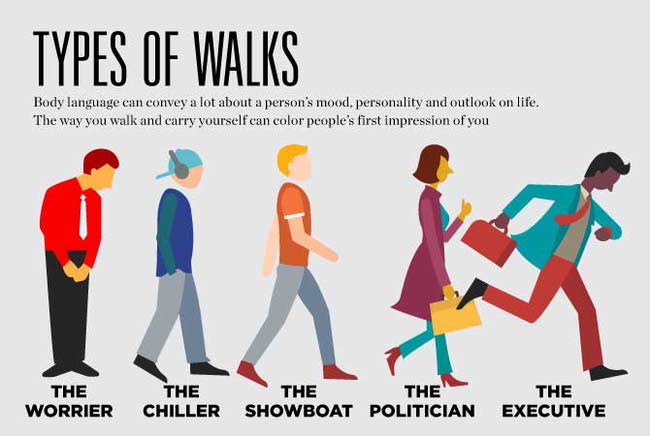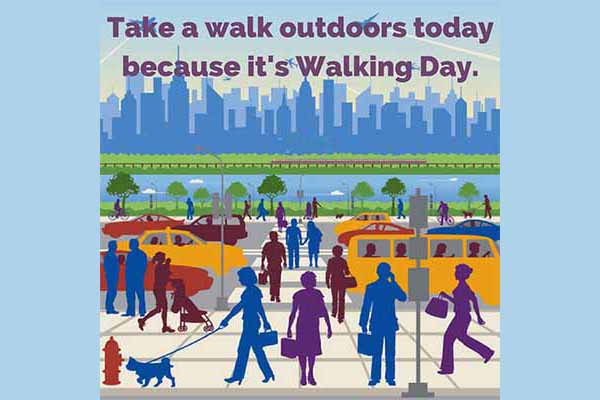

The way you walk can reflect various aspects of your personality, mood, and even your physical health. It can convey confidence, anxiety, or indifference, and can be influenced by factors such as your emotional state, physical fitness, and self-esteem. Additionally, cultural influences and social contexts can shape walking styles. Overall, your gait can serve as a non-verbal communication tool, expressing more than just how you move from one place to another.
Walking affects mental as well as physical health. Be discerning about your walking routine not as a means of compulsive behavior, but as something that you consider part of your health regime.
Walk according to your age, health, weight, environmental factors and more. Don't become compulsive about it. If your muscles tell you that you're over stressing - Stop!
War the proper footwear for you. Walk on an even surface. Always take a bottle of water with you. Wearing a headset is okay as long as you stay aware of your surrounding areas.

Walking Pets: Be careful that the animal you're walking - such as a larger dog - does not pull you too hard so you trip and fall.
Injury Risk: Walking, especially over long distances or on uneven surfaces, can lead to injuries such as sprains, strains, or stress fractures. Conditions like plantar fasciitis or shin splints can also arise from improper footwear or overexertion.
Fatigue: Extended periods of walking can lead to physical exhaustion, particularly for those who are not accustomed to regular activity or who walk long distances without adequate rest.
Environmental Factors: Walking outdoors can expose individuals to adverse weather conditions, such as extreme heat, cold, or rain, which can lead to discomfort or health risks like hypothermia or heat exhaustion.
Safety Concerns: Walking in certain areas can pose safety risks, such as traffic accidents, crime, or encountering aggressive animals. Poorly maintained sidewalks or lack of pedestrian crossings can also increase the risk of accidents.
Social Perception: Some people may feel self-conscious about their walking style or speed, which can lead to anxiety or discomfort in social situations. This can be particularly true in environments where there is pressure to keep up with others.
Accessibility Issues: Not everyone has equal access to safe walking environments. Individuals with mobility challenges may find it difficult to walk due to lack of infrastructure, such as ramps or smooth surfaces.
Overexertion: For those who are not physically fit, walking too much or too quickly can lead to overexertion, resulting in muscle soreness or cardiovascular strain.
Poor Posture: Walking with improper posture can lead to long-term musculoskeletal issues, including back, neck, or joint pain.
Mental Health Factors: While walking can have positive effects on mental health, for some individuals, it may also evoke feelings of loneliness or sadness, especially if they associate walking with negative experiences.
Time Consumption: In a fast-paced world, walking can be seen as a slower mode of transportation, which may not be practical for those with time constraints or who need to travel long distances quickly.

Casual Walk: A relaxed and easy pace, often seen when someone is strolling or enjoying a leisurely moment.
Power Walk: A brisk and purposeful gait, often characterized by swinging arms and a faster pace, typically associated with exercise or a strong sense of purpose.
Swaying Walk: A style where the hips sway noticeably, which can be seen in more relaxed or confident individuals.
Shuffling Walk: A slower, less energetic style where the feet drag slightly, often associated with tiredness or reluctance.
Tiptoe Walk: Walking on the balls of the feet, often used by children or in playful contexts, but can also indicate nervousness or caution.
Strutting: A confident and exaggerated walking style that often involves a wide stance and a proud posture, signaling self-assuredness.
Pacing: Repeatedly walking back and forth, often seen in individuals who are anxious or deep in thought.
Limping: An uneven gait that may indicate injury, discomfort, or a physical condition.
Marching: A rhythmic and often military-style walk that involves lifting the knees high and maintaining a straight posture.
Side Stepping: Moving sideways, often used in dance or when navigating tight spaces, but can also indicate playfulness or caution.
Each walking style can convey different emotions and intentions, and can be interpreted in various ways depending on the context.
While walking is generally considered a healthy and beneficial activity, there can be negative aspects or consequences associated with it in certain contexts.
Overtaxing the body to relieve stress is detrimental to area such as knees, ankles, and other areas that can become arthritic and will later have to be replaced.

National Walking Day is the first Wednesday of April
One small walking adjustment could delay knee surgery for years by making a small adjustment to the angle of their foot while walking Science Daily - August 16, 2025

Nearly a quarter of people over the age of 40 experience painful osteoarthritis, making it a leading cause of disability in adults. Osteoarthritis degrades joint-cushioning cartilage, and there is currently no way of reversing this damage: the only option is to manage pain with medication, and eventually, joint replacement.

In the game of life, most people have unresolved issues with someone from their past, something left unsaid and undone. It could be a family member, a friend, a former neighbor, someone whose behavior towards them has left a marker on their soul. These unresolved issues can damage their lives, whether they recognize them or not.
Therapy can help one relive the experience bringing it into today's consciousness for review, but another good way to let go might be to meet the person involved, if they are still alive and can be found.
As everything goes to fear and other negative emotions, if one is ready, this can be a turning point in life. It can create something positive or help let go of someone negative as you do not want your soul to carry excess baggage being a pawn on the game board trapped in negative emotions (red).
As we have discussed, most people are dysfunctional in one way or another, thus experience is about abuse and healing.
Most people who have hurt you have their own set of issues and emotional problems that you may not have recognized. To let go is to understand why they behaved as they did and your needs at the time you were abused.
A reunion with the person is more about understanding than any other emotion. It is not to rekindle lost, or never existing, affections. It is to teach you about the people who played karmic roles in your life and how their presence has made you the person you are today.
We live in a time when many of us let go of the destructive people in our lives - friends and family. But if there is someone who you need to see again, to make a clean break, go for it.
a star seed, a tree, a man, a woman,

and an apple that contained all knowledge.

You do remember where the ruby red slippers take you?
